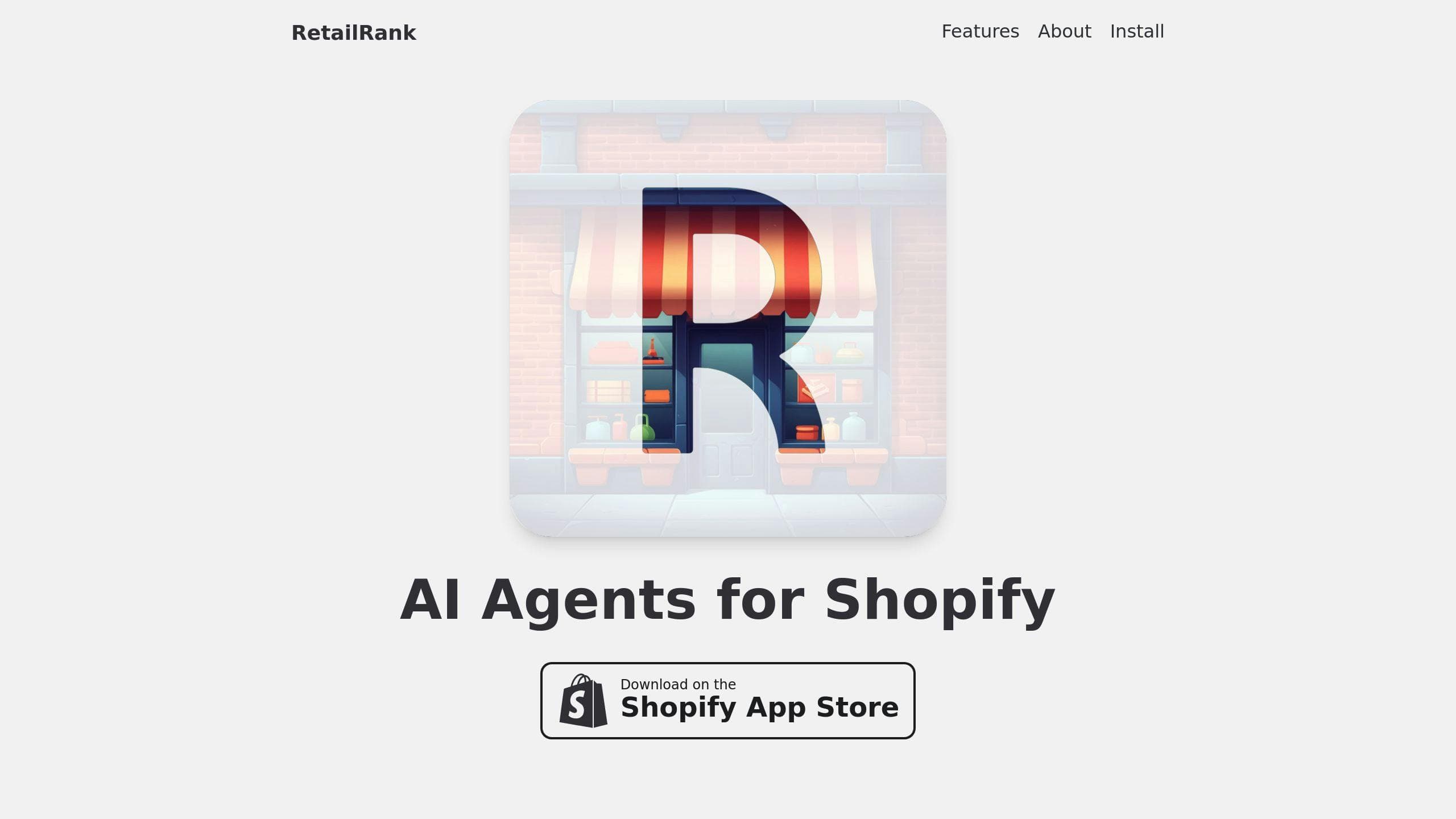
How to Write SEO-Friendly Alt Text for Product Images
Alt text is essential for improving SEO, accessibility, and product visibility, especially for ecommerce stores like Shopify. Here's how to do it right:
- What is Alt Text? A short, clear description of an image that helps search engines and screen readers understand its content.
- Why It Matters: Boosts SEO (Google uses it to rank images), ensures accessibility for visually impaired users, and enhances user experience.
- Common Mistakes to Avoid:
- Keyword Stuffing: Overloading with keywords can hurt SEO.
- Vague Descriptions: Use specific details instead of generic terms like "product image."
- Missing Alt Text: Skipping it reduces visibility and accessibility.
Tips for Writing Effective Alt Text:
- Be clear and specific: Describe key features like color, material, or unique details in 8-10 words.
- Use keywords naturally: Avoid forcing them; keep descriptions readable.
- Leave decorative images blank: Use
alt=""for non-essential visuals.
For large catalogs, tools like RetailRank or TinyIMG can automate alt text creation, saving time while maintaining quality.
| Tool Name | Features | Pricing | Pros | Cons |
|---|---|---|---|---|
| RetailRank | AI-generated alt text, templates | Free - $29/month | Great for SEO | Advanced features cost more |
| TinyIMG | Bulk editing, compression | Free - $19/month | Speeds up site loading | Limited AI capabilities |
| Image Alt Text Optimizer | Basic automation | Free | Easy to use | Minimal customization |
Bottom Line: Writing clear, descriptive alt text improves SEO, accessibility, and product visibility. Use manual updates for small catalogs or automation tools for larger inventories. Regularly audit and update your alt text to stay relevant.
How To Write Great Image Alt Text And Get More SEO Traffic
::: @iframe https://www.youtube-nocookie.com/embed/-jn9aaNn8_I :::
Tips for Writing SEO-Friendly Alt Text
The aim is to create descriptions that help search engines and screen readers while meeting accessibility standards.
Write Clear and Specific Descriptions
Focus on describing the key visual details that set your product apart. Mention features like color, style, material, or unique details. Keep it concise - 8-10 words work best for clarity without overloading.
| Good Alt Text | Bad Alt Text | Why It Matters |
|---|---|---|
| "blue athletic cap with mountain logo" | "hat photo" | Gives specific details, helping users and search engines understand the product. |
| "hydrating water bottle with lid" | "water bottle for sale" | Highlights key features using natural language. |
| "ceramic mug with gold rim" | "mug product image" | Points out unique elements that distinguish the product. |
Add Keywords Without Overloading
Naturally include target keywords in your descriptions, but don’t force them. Prioritize readability over stuffing in terms. For example, if "leather wallet" is your keyword, write something like: "brown leather wallet with card slots and coin pocket."
Leave Decorative Images Blank
Decorative images, like background patterns or dividers, don’t need alt text. Use empty alt text (alt="") for these. This helps screen readers bypass unnecessary elements, keeping the focus on meaningful content.
Google's Search Generative Experience (SGE) factors in alt text when ranking images. By writing clear, keyword-rich descriptions for product images and skipping alt text for decorative ones, you create a smoother experience for users and improve your SEO.
For larger stores, automation tools can help streamline the process of writing alt text efficiently.
Using Tools to Automate Alt Text
Handling alt text for large product catalogs can be a tedious task. Automation tools can simplify this process while ensuring your site meets SEO and accessibility standards.
Overview of RetailRank

RetailRank uses AI to create optimized alt text, offers custom templates, and automates updates for new product images. It provides both free and paid plans. The Pro plan ($29/month) includes more advanced SEO features and automation tools.
Comparison of Alt Text Tools for Shopify

If you're a Shopify user with a large catalog, these tools can make optimizing alt text easier while keeping your site accessible and SEO-friendly. Here's a quick comparison of the top options:
| Tool Name | Key Features | Pricing | Pros | Cons |
|---|---|---|---|---|
| RetailRank | AI-generated alt text, custom templates | Free - $29/month | Great for SEO | Advanced features require Pro plan |
| TinyIMG | Bulk editing, image compression | Free - $19/month | Boosts page speed | Limited AI functionality |
| Image Alt Text Optimizer | Basic automation | Free | Easy to use | Minimal customization options |
"Using non-smart ALT-Text bulk apps that simply read the product title and variant and input it as ALT Text can lead to irrelevant content and ADA non-compliance."
When picking a tool, look for features like AI-powered image analysis, custom templates to maintain branding, and built-in SEO support. After choosing the right tool, focus on implementing alt text effectively within Shopify.
sbb-itb-38bb0d4
How to Add Alt Text in Shopify
Adding alt text to your Shopify product images is a simple process that can improve both accessibility and search engine visibility. Here's how to do it manually or with the help of apps.
Steps for Adding Alt Text Manually
You can easily add alt text to your product images directly through Shopify's admin panel. Follow these steps:
- Go to your Shopify admin dashboard and navigate to Products > All products.
- Choose the product with the image you want to update.
- Click on the specific product media item.
- On the Preview media page, locate and click Add ALT text.
- Enter a descriptive alt text for the image.
- Hit Save ALT text to apply your changes.
This method is ideal for smaller stores or when you want to carefully craft each description.
Using Apps for Bulk Alt Text Editing
If your store has a large catalog, adding alt text manually can be overwhelming. Bulk editing apps like RetailRank and TinyIMG make the process faster and more efficient.
Here’s how to use a bulk editing app:
- Download and install a bulk editing app from the Shopify App Store.
- Access the app's dashboard in your Shopify admin panel.
- Select the product images you want to update.
- Use the app to generate or input alt text descriptions.
- Review the changes and apply them.
Manual updates work well for smaller stores with fewer than 50 products, while apps are a great option for saving time with larger inventories. Tools like RetailRank ensure your alt text remains optimized without the hassle of editing each image individually.
Final Thoughts on Optimizing Alt Text
Why Well-Written Alt Text Matters
Good alt text doesn’t just improve accessibility - it also plays a big role in driving traffic to your Shopify store. With images showing up in 19% of Google search results, having optimized alt text can increase your organic reach. It also ensures that visually impaired users relying on screen readers can navigate your site more easily.
Here’s how strong alt text can make a difference:
| Benefit | How It Helps |
|---|---|
| Better Search Visibility | Makes images easier for search engines to index and match to keywords |
| Improved User Experience | Offers clear descriptions when images don’t load properly |
| Increased Sales Potential | Boosts product visibility in image searches, leading to more clicks and purchases |
By keeping your alt text clear, descriptive, and optimized, you can make your store more accessible and improve its overall performance.
Practical Tips for Shopify Store Owners
Keep your alt text short but descriptive - aim for 8-10 words. For example, instead of writing something generic like "blue hat", go with "blue athletic cap featuring mountain logo." This level of detail helps both search engines and users better understand your products.
If you’re managing a large inventory, consider using tools like RetailRank or TinyIMG. These tools can automate alt text optimization while preserving the quality and detail needed to make your product descriptions stand out. This way, you can ensure consistency across your store without losing the personal touch that engages your customers.
FAQs
What should go in the alt text of an image for SEO?
Good alt text is clear, descriptive, and includes relevant keywords to boost both SEO and accessibility. Here's what to focus on:
| Element | Example | Purpose |
|---|---|---|
| Product Details | "Smokey blue athletic ball cap" | Describes the main product features |
| Unique Features | "with white mountain logo stitched front" | Highlights specific attributes |
| Context | "white background" | Adds extra relevant details |
Aim for descriptions that are 8-10 words long. Keep them accurate and naturally include keywords. If you're managing a large catalog, tools like TinyIMG or Avada SEO Image Optimizer can help you stay consistent and follow SEO guidelines.
How often should I update alt text for my Shopify store?
Update your alt text in these situations:
- Launching new products
- Making major product updates
- Adjusting your SEO strategy
- Responding to new search trends
- Running seasonal marketing campaigns
To stay on top of things, schedule audits every 3-6 months to ensure your alt text stays relevant and effective for both search engines and users.
Boost your Shopify SEO today
Focus more on making great products. Not on optimizing for SEO.